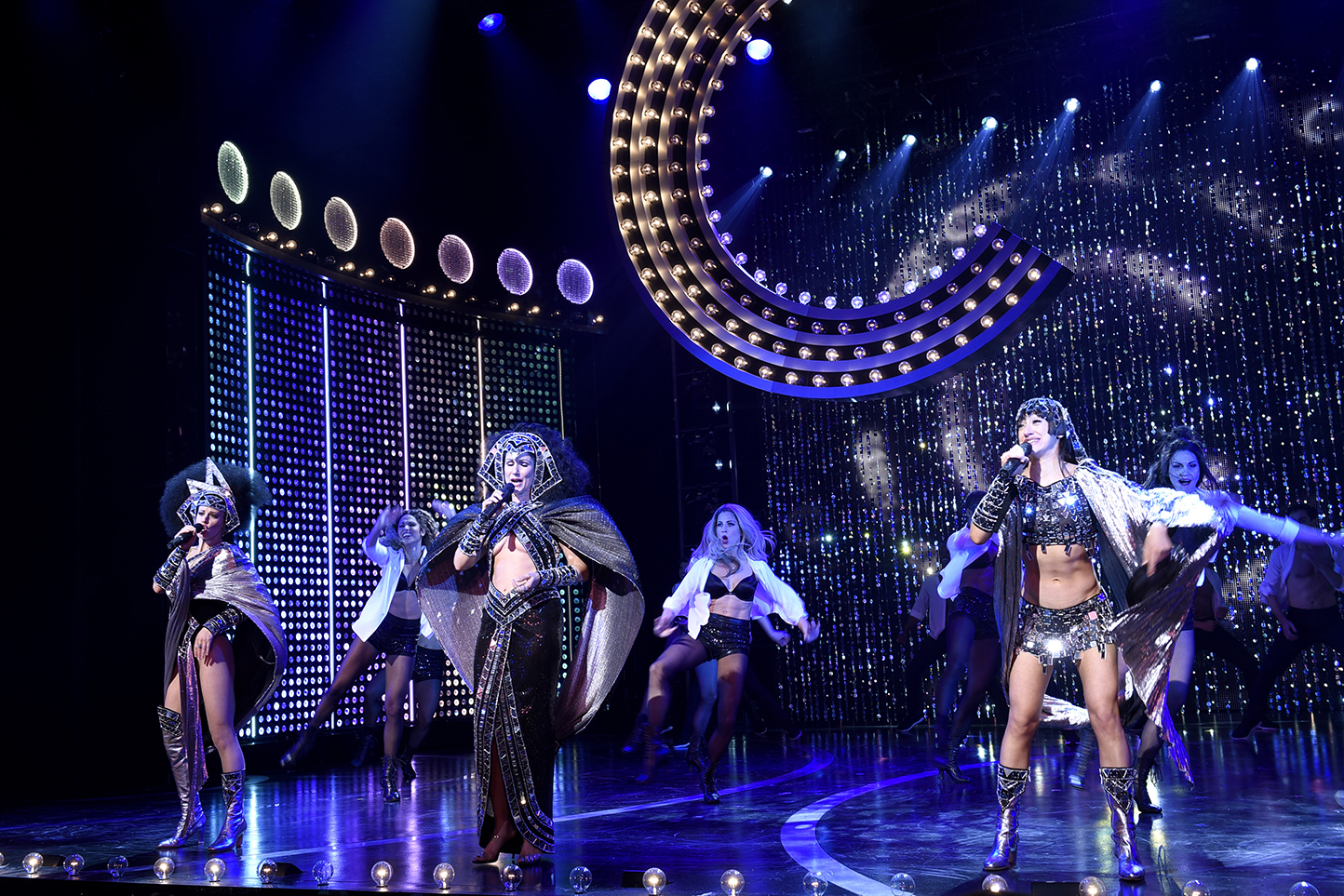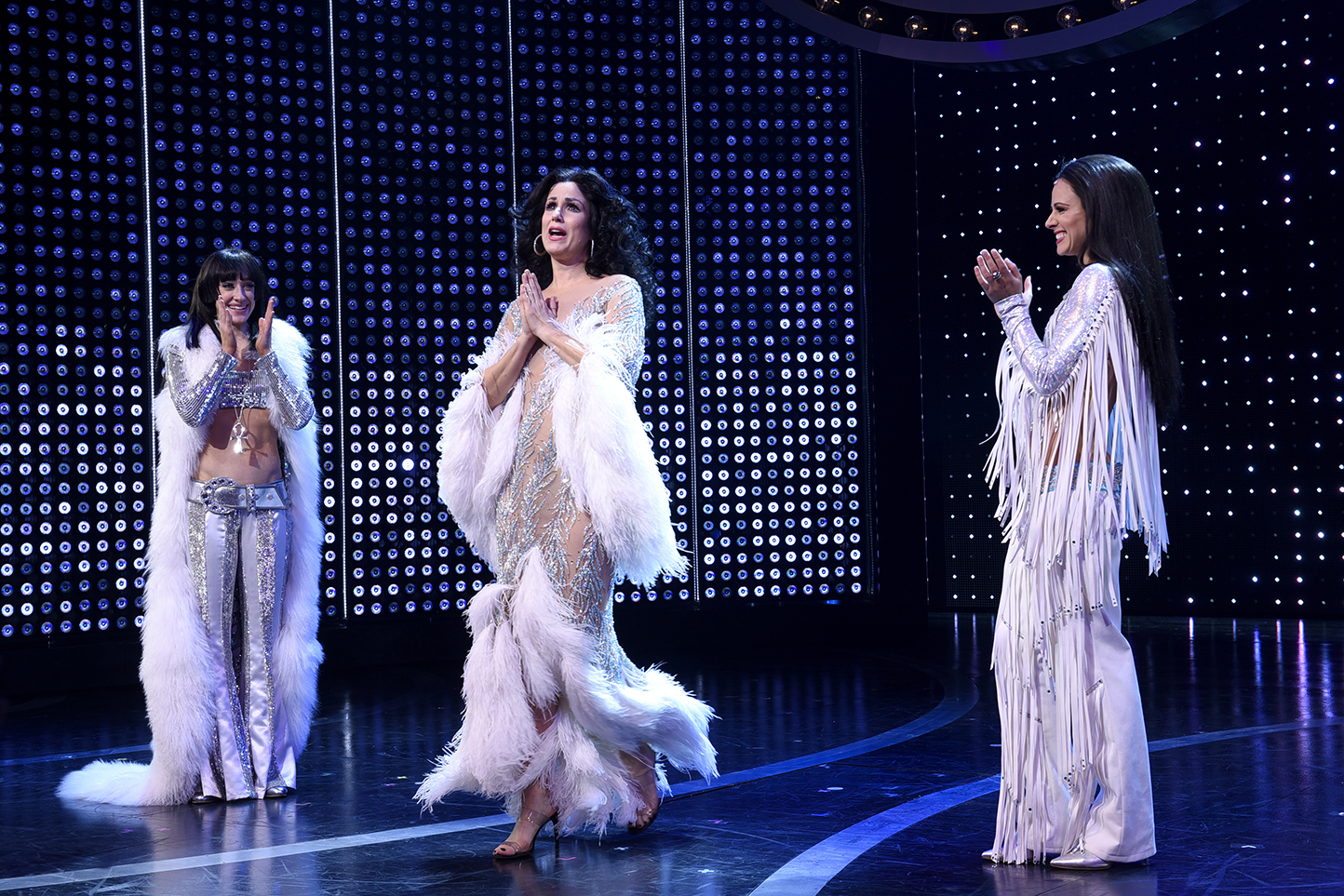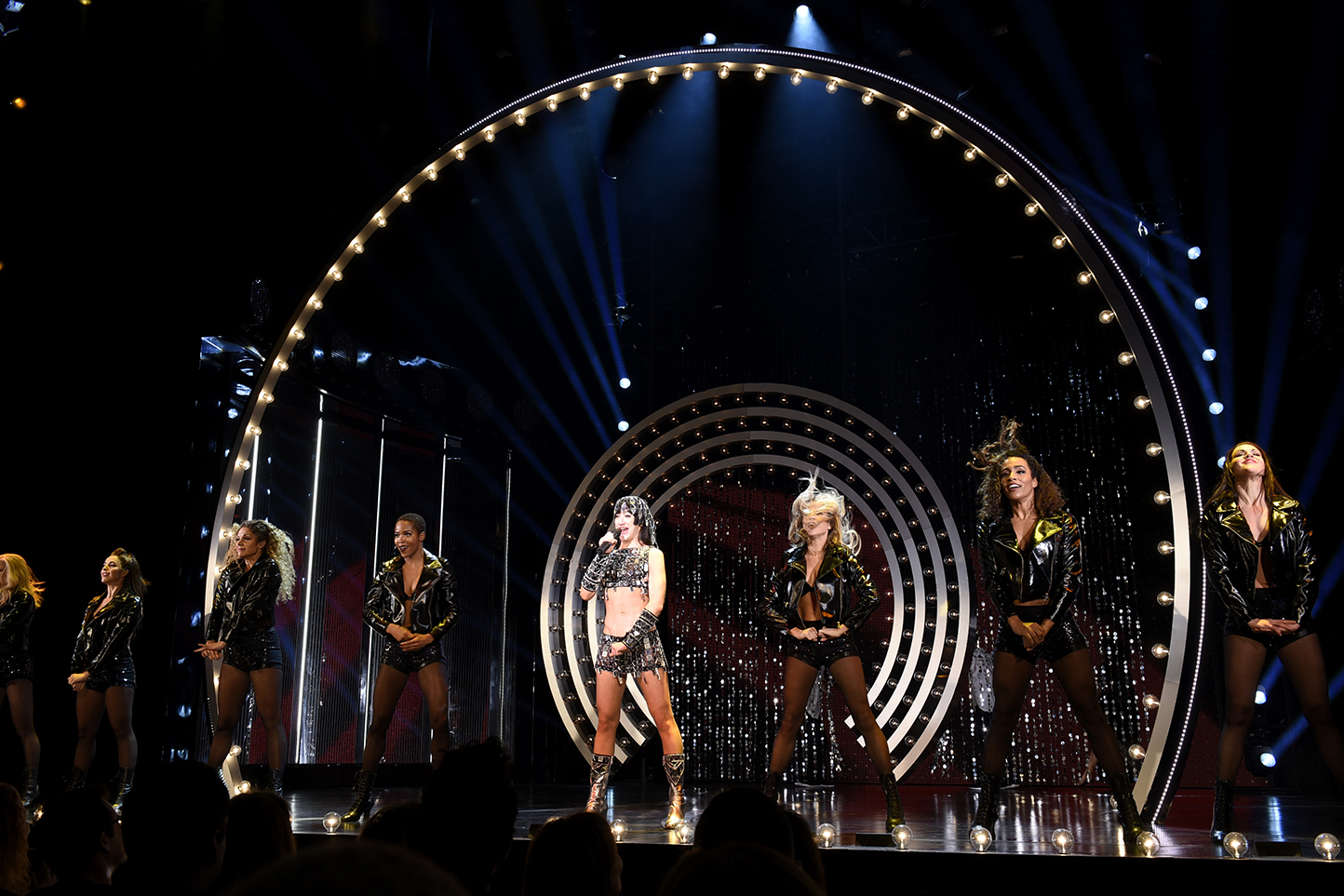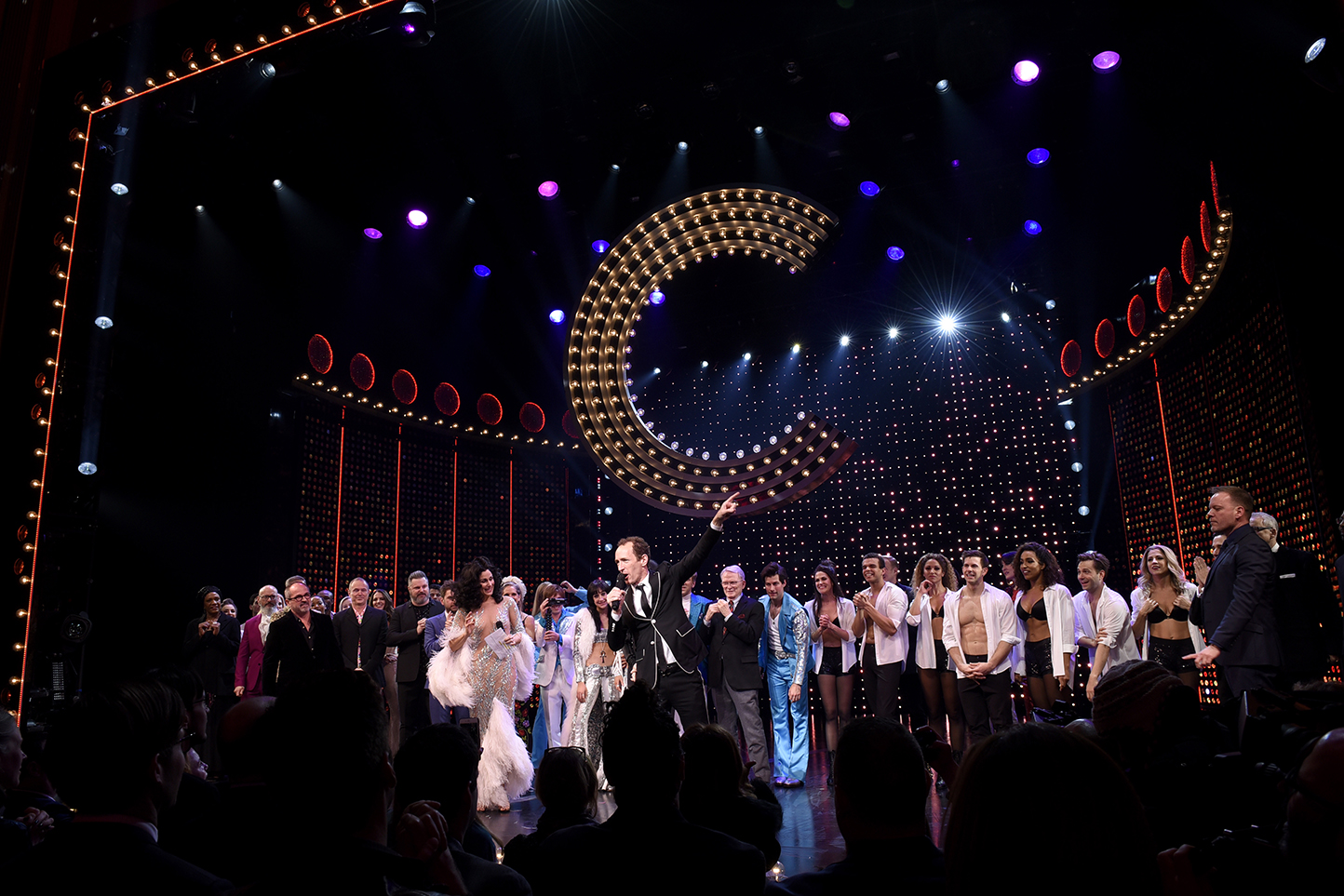The Cher Show is pure exuberance. This glitterbomb of a musical, written by Rick Elice, directed by Jason Moore, and staged at Broadway’s Neil Simon Theatre, takes audiences on a whirlwind journey through Cher’s six-decade career: Three actresses portray the 72-year-old legend at pivotal phases of her life, telling her story through 35 musical numbers that range in scope from intimate ballads to full-blown rock productions. And it’s all wrapped in a dizzying array of wigs, sparkles, and stunning Bob Mackie costumes evoking the diva’s most iconic looks.
Sound design for The Cher Show is by Nevin Steinberg, a theater veteran who’s worked on dozens of productions on and off Broadway, including Hamilton, Dear Evan Hansen, and Bright Star. He recently won a Laurence Olivier Award for his work on Hamilton and has earned numerous Drama Desk Awards and Tony nominations. (Prior to 2012, he designed as a founding partner of prolific sound design firm Acme Sound Partners.) I sat down with Steinberg to learn about his strategies for capturing the essence of Cher, in music and spirit.
Sarah Jones: Have you worked with Jason Moore before?
Nevin Steinberg: Jason and I go back to Avenue Q when it made a Broadway transfer; back at the time, I was a partner in Acme Sound Partners, and we were hired to do sound when Avenue Q moved from The Vineyard Theatre off-Broadway to Broadway.

Photo by Jenny Anderson, Getty Images
SJ: What's your process like as far as providing sonic context for his vision?
NS: Every director is different in how they express their ideas about how a show should sound. A lot of how Jason expressed his ideas about the show centered around what it was going to feel like and look like. We had conversations about the overall tone of the production, which we extrapolated into how it would sound and feel. We were able to do a couple of readings and workshops of the show, which gave us some vocabulary right from the beginning of the development process.
SJ: As you were going through that process, what were your biggest priorities?
NS: My concern was the show has a presentational element. There are segments of the show that are directed at the audience. There are segments of the show that are kind of excerpts from a variety show format. And there are segments of the show that are full-on concert-type elements.
And then there's the intimate human moments, more like the play within the show, and the humanity of the characters has to really come through there. There's a real contrast in that, and navigating that is part of the trick. And then there's just the span of time. Cher has had a multidecade career, and the story begins in her childhood and travels through time to the present. It's important for us to help honor that as well.

Photo by Jenny Anderson, Getty Images
SJ: Three actors play Cher at different stages of her life. Were you looking to provide sonic continuity across a chronology, or create distinct senses of space?
NS: No, they share the same world; they appear onstage pretty frequently together. So we don't really separate them. That's an interesting idea, and if the play had been written differently, that might have been the way we went. But even though each one represents Cher at a different stage of her life and career, Rick Elice, the writer, and Jason Moore didn't draw boundaries about when we would see or hear the individual. They sort of drift in and out of each other’s lives and time periods.
SJ: Were you looking to provide consistency as far as creating that signature Cher voice?
NS: That's in their vocal production, so we don't have a lot of responsibility in terms of making them sound like Cher; that voice is part of the character that they've developed.
SJ: It must be a challenge to maintain vocal intelligibility over everything going on onstage.
NS: We need to make sure the audience can follow and understand the story. There's a lot of action in Cher. It moves very quickly; you can be easily distracted. But Jason and Chris Gattelli, our choreographer, are masters at helping the audience know where to look and who to listen to. My support is much easier when folks like Jason and Chris are guiding the audience through that journey with staging and lighting and all of that.

Photo by Jenny Anderson, Getty Images
SJ: How does your sound design help keep the focus on them?
NS: Well, part of it is a fanatical adherence to the humanity of the vocal reproduction. I've always felt like my job as a sound designer, regardless of how amplified something is, is to never lose the sense that it’s still coming from the human in front of you. And you’re being able to stay connected to them in some way. That's a very complicated witches’ brew of technical and taste approaches, but the ultimate goal is to always make sure the thing that's happening in front of you is coming from the people and not from some external electronic source.
SJ: These are pop songs. Are you evoking certain eras of pop and rock production styles?
NS: I go through each tune and try and figure out not only what we need in terms of the signature style of that tune or that period, but also what we can get away with given the fact that we’re still in a Broadway theater and we’re still communicating a story. So that just depends on context. But yes, that’s a combination of vocal processing, reverb, and other external processing.
A lot depends on the charts. Daryl Waters, who did the orchestration and the music supervision, is really responsible for helping us draw a line from one thing to the next. We talked a lot about, rather than trying to reproduce the exact elements of the recording that people know, trying to capture the spirit of it. And in the same way that I approach sound design by trying to adhere to the humanity of the performers, it's also important to honor the fact that there's a live orchestra playing and that we never get the sense that it’s just been canned or piped in.

Photo by Jenny Anderson, Getty Images
SJ: How does your sound design inform the gear that you spec out?
NS: The first thing has to do with the venue. What does the venue require? And then you sort of work inwards from the other side, which is, what do we require to deliver the kind of audio that we want to deliver? And in this case, it was a pretty wide dynamic range, from an intimate scene between mothers and daughters to concert-level reproduction. And then there's a big dance remix at the end. So you have to be mindful about being able to have the headroom to do the things you want to do at the end but still have the sensitivity to navigate the internal moments.
SJ: Do you seek out gear that provides certain sonic signatures?
NS: For processing, I try to just give myself a lot of tools, and in this case, the outboard processing is a Waves SoundGrid server, so there was sort of a limitless toolbox for anything we needed, whether we wanted to put a sheen on something or insert processing on lavaliers or handhelds. That's how I approached this one—just to make sure that we didn't find ourselves without something we needed. And Waves give you a lot of flexibility.
SJ: What about your production and communications workflow? What are your biggest needs there?
NS: We've been using the ClearCom HelixNet system for a couple years now, and it just gives a lot of flexibility that we didn't have before with the party line system, and it saves a lot of install and headaches from the communications side.
SJ: What’s been the most fun for you, in this production?
NS: I like it when we break out in the middle of the show to a kind of performance mode where we go from what feels like more of a traditional musical to the performance variety stuff, that's always fun for me, because it's kind of a middle ground between full-out concert environment and a traditional Broadway musical.
It doesn't play by all the rules of chronology, or even many of the rules of the things we might expect of a live story-slash-catalog musical. To a certain extent, we’re sort of hanging on for the ride. I think that's part of the vibe. Cher's long career and long life has been well documented and full of exciting twists and turns, and I think that's what we’re trying to do.

Photo by Jenny Anderson, Getty Images
The Cher Show Sound Team
- Associate Sound Designer: Jason Crystal
- Assistant Sound Designer: Connor Wang
- Production Sound: Mike Wojchik
- Head Sound Engineer: Jake Scudder
- Deck Sound: Scott Silvian, Duane McKee
The Cher Show Tech Highlights
- Console: DiGiCo SD7T
- Processing: Waves SoundGrid
- Loudspeakers: d&b audiotechnik Y8, Y12, Y7P, V7P, E4, E5, JSUB; Alcons Audio VR8, SR9; EAW JF80z
- Loudspeaker Processing: Meyer Sound D-Mitri
- Wireless systems: Shure ADX1M and Sennheiser SK-5212 bodypack transmitters; Shure AD4Q and Sennheiser EM-3732-II receivers; Shure AD2/BETA87A handheld transmitters
- Lavalier microphones: DPA 4061 and 6061
- Orchestra: Shure, Audix, beyerdynamic, DPA, Radial
- Communications: ClearCom HelixNet
Sarah Jones is a writer, editor, and content producer with more than 20 years' experience in pro audio, including as editor-in-chief of three leading audio magazines: Mix, EQ, and Electronic Musician. She is a lifelong musician and committed to arts advocacy and learning, including acting as education chair of the San Francisco chapter of the Recording Academy, where she helps develop event programming that cultivates the careers of Bay Area music makers.